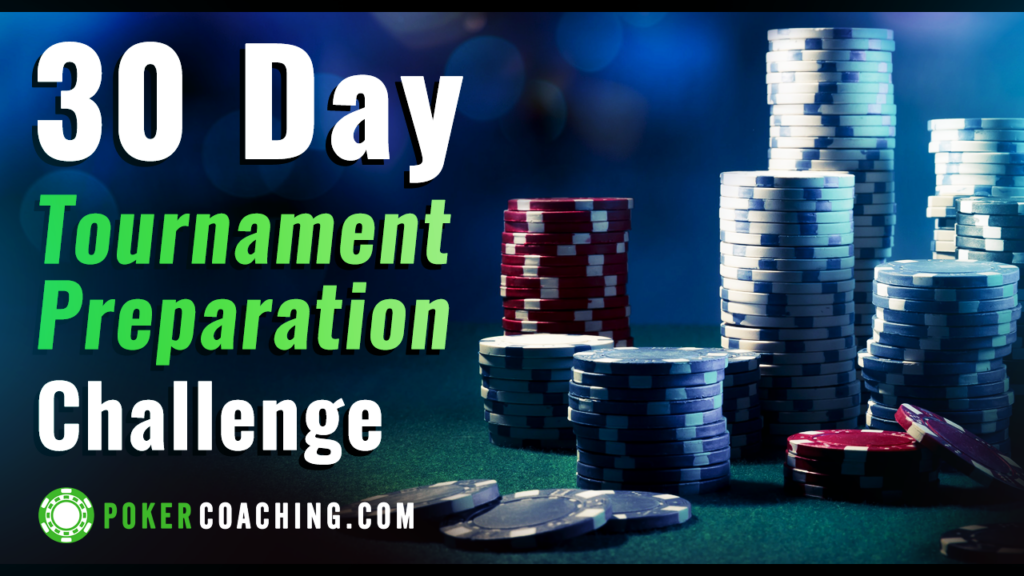PokerCoaching.com released an outstanding series of ‘Learning Paths’ to guide students through the plethora of content available on the site. Well, the good news for students continues, as Jonathan Little and his team have continued to add lengthier, structured curriculums to the site in the form of multi-faceted ‘challenges’. Originally, these challenges are presented with a new lesson added daily for PokerCoaching.com students to tackle.
But with several of the challenges now completed, they’re available in their entirety in the ‘Challenges’ section of the site. Think of it as your favorite poker TV show being released episodically, then once the season is complete the entire season is released and available to binge or consume whenever you desire.
There are a few of these multi-lesson challenges available, but in this review we’re looking at the 30-Day Tournament Preparation Challenge. For 30 consecutive days a new video lesson was released, accompanied by a short quiz upon completion to test your newfound skills. Now, as mentioned, all 30 days of content are available on demand, and can be consumed in whichever order you choose. First, here’s a look at the list of all 30 lessons:
- Learning Your Opponents Through Preflop play – Jonathan Jaffe (35 min)
- 3-betting at Different Stack Depths – Jonathan Little (12 min)
- Exploitative Plays to Crush Live Tournaments part 1 – Faraz Jaka (62 min)
- Short Stack Preflop Play – Matt Affleck (80 min)
- Exploitative Plays to Crush Live Tournaments part 2 – Jaka (50 min)
- Short Stack Post-flop Play – Affleck (64 min)
- $10k Bellagio Day 1 & 2 Review – Jaffe (83 min)
- Live Play & Explain Part 1 – Little (38 min)
- Button vs Big Blind Play – Jaffe (91 min)
- Advanced Big Blind Defence Strategies in Tournaments – Affleck (73 min)
- Review of Blaz $10 Online Tournament Win Part 1 – Little (21 min)
- Review of Blaz $10 Online Tournament Win Part 2 – Little (23 min)
- Review of Blaz $10 Online Tournament Win Part 3 – Little (18 min)
- How to Complete PokerCoaching Homework – Little (24 min)
- Complete October 2019 Tournament Homework – Little (37 min)
- Reviewing Jonathan’s Deep Run in the Online $1k Freezeout Part 1 – Michael Acevedo/Little (61 min)
- Reviewing Jonathan’s Deep Run in the Online $1k Freezeout Part 2 – Acevedo/Little (102 min)
- Live Play & Explain Part 2 – Little (49 min)
- Mastering the HUD: VPIP & PFR – Alex Fitzgerald (33 min)
- Mastering the HUD: C-Bet Statistics – Fitzgerald (35 min)
- Mastering the HUD: Fold to C-Bet Statistic – Fitzgerald (12 min)
- Mastering the HUD: Check-Raise Statistic – Fitzgerald (13 min)
- Mastering the HUD: Test Your Skills – Fitzgerald (72 min)
- Live Play & Explain Part 3 – Little (50 min)
- Bubble Thoughts – Little (22 min)
- Introduction to ICM – Affleck (92 min)
- Mastering High Roller Final Tables Intro & Part 1 – Little (30 min)
- Mastering High Roller Final Tables Part 2 – Little (27 min)
- Mastering High Roller Final Tables Part 3 – Little (27 min)
- Tips to Crush Small Stakes Tournaments & Final Exam (30 questions) – Little (63 min)
In total, this adds up to almost 24 hours worth of elite No Limit Hold ‘em training content.
My recommendation for consuming this challenge would be to tackle it in one of two ways: either as originally intended with one lesson per day over 30 days, which is the most easily digestible process, or by combining the multi-part lessons and consuming those together in slightly longer chunks.
For example, Faraz Jaka’s 2-part series on Exploitative Plays to Crush Live Tournaments could be watched together. Moreover, Days 11-13 could easily be watched in one sitting, as they are a 3-part hand history review. Also, if you wanted to merge lessons on pre- and post-flop short stacked play, Matt Affleck’s Day 4 and 6 lessons could be watched together.
There are other examples of this as well, and for the purposes of a more easy-to-follow review of the content, I’ll be combining those lessons and reviewing them one section at a time, with their days of the challenge denoted at the top of each section.
Now, with that all said, let’s dive into it!
Day 1: Learning Your Opponents Through Pre-flop Play
I was very happy to see this lesson, which I’ve discussed in previous reviews, included in the challenge, and even kicking it off on Day 1 no less.
Jonathan Jaffe takes students through a series of pre-flop situations and provides analysis of what tendencies a player will have based on their actions. A super light raise from early position obviously suggests a loose/maniacal player, but there can be a lot more behind that raise. Getting reads on your opponents is critical, and Jaffe guides the student through the multitude of other things to consider. This is a lesson that’s useful for players of all skill levels.
Day 2: 3-betting at Different Stack Depths
Jonathan Little brings us an intensive crash course on how you should be 3-betting, outlining the many different strategies required based on your stack size. Range charts are provided for a variety of stack depths, from 15 BB to 75 BB and up, along with a chart breaking down what 3-bet sizing you should be using, based on your stack depth.
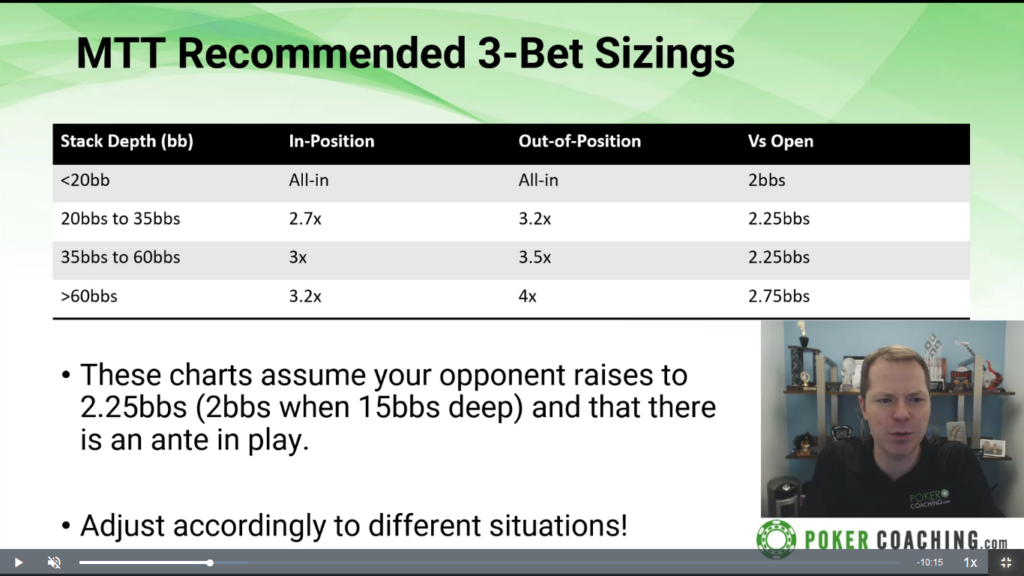
The importance of 3-betting with good blockers when short stacked vs. 3-betting with a more linear range when deep is discussed, along with what stack size your 3-bets should be an all-in.
Plus, Little lays out the situations in which you should defend more and not 3-bet from the big blind when short.
Days 3 & 5: Exploitative Plays to Crush Live Tournaments Parts 1 & 2
Given that this review was originally written during the COVID-19 pandemic with live tournament poker at a minimum around the world, I’ll admit that I saved these videos for last. And wow, was I pleasantly surprised by how much of these videos are also applicable to the online game, notably smaller stakes where players are very exploitable!
Part 1 focuses on pre-flop exploits, such as how to target weak opponents, exploitative blind stealing, 3-bet attacks, and the ever popular psychological warfare! Getting too boggled down in the specifics would take too much time, but I will mention one critical concept of playing strong exploitative poker: you are going to be playing more hands. Maybe not as many as Faraz Jaka is known to, but to play this style effectively, you will be widening your ranges. (Jaka will explain where and when are the best spots for this throughout – it actually ties together nicely with theories from Jaffe’s lesson on learning your opponents’ pre-flop play. The supposed maniac raising suited Kx in early position? Well here he is.) As such, YOU MUST BE FOCUSED and paying incredible attention to the table and know how to potentially exploit each player.
Of note in part 1, easily the coolest slide I’ve seen in any poker training material out there is Jaka’s section on psychological warfare. That’s right, sorry to disappoint, but you don’t want to be the Macho Man when you’re playing. Oooooooooh…no?

Part 2 goes into post-flop play, with a lot of discussion on downbetting and smaller post-flop bet sizes, except when you can exploitatively use larger sizing against the non-believers to maximize value. The importance of recognizing and overfolding against players who are completely unbalanced in their ranges is also discussed.
Jaka wraps the series by analyzing several live hands he’s played, including a cool hand against Jessica Dawley at the final table of the Seminole Hard Rock Poker Open, and why at a table with just them and three amateurs, he felt she was the player he could most successfully exploit.
Days 4 & 6: Short Stack Pre-flop and Post-flop Play
If I was compelled to pick something as the best or most important section of the series, Matt Affleck’s videos on short-stacked play would get my vote. This is mainly because, as Affleck himself notes, of any element of tournament poker short stack is what you’ll be playing the most, and it’s an area where you can create more EV than the majority of your opponents.
The pre-flop video discusses the hugely important concept of ‘lazy shoves’ and how to better play a 15-20 BB stack by using split ranges. Sure, just piling in your 15 BB stack with KQo in the hijack is profitable, but if you take a more strategic polarized/linear approach, there is much more EV to be made.
Affleck breaks down which hands to instead min-raise and call off to a 3-bet shove, which hands to min-raise/fold, and which are still just a straight shove.
Re-jamming is also discussed thoroughly, with the key concepts of getting hands you dominate to call and getting hands that dominate you to fold!
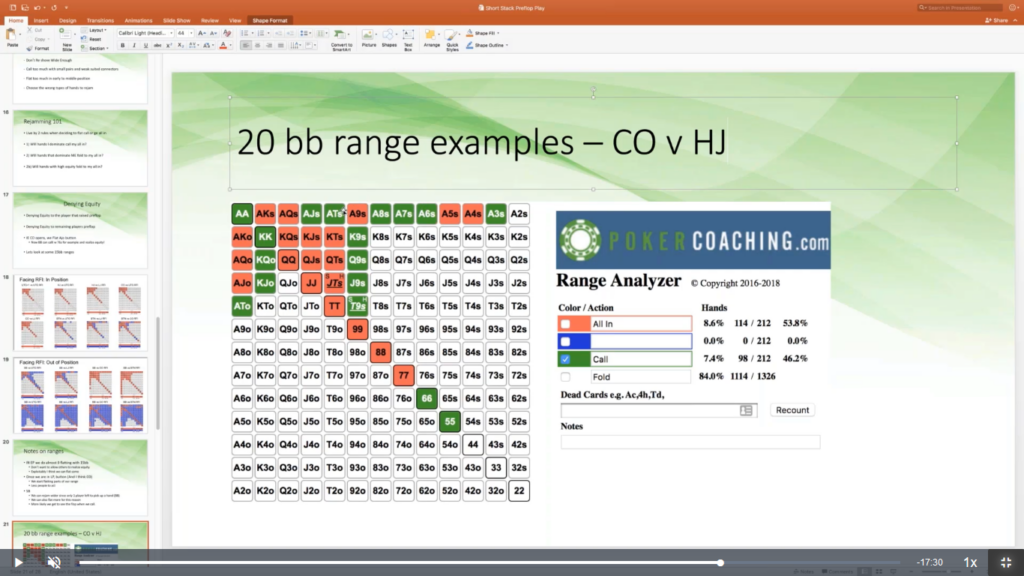
Why are we 3-bet shoving A9s, A5s and A4s along with AKs and AQs, but not AJs and ATs?
These are solid GTO baselines for 3-bet jamming, but Affleck also notes that there are plenty of opponent-based exploits that must be considered as well.
The short stack post-flop video uses a lot of PioSolver and hand breakdowns to analyze what your best options are with a shallow stack-to-pot ratio (SPR). I think many amateur players would be surprised how much play you have on a sub-25 BB stack. Protection and equity denial is king, and every 4-5 BB pot you can drag when short stacked is a huge win. Affleck guides you through when your top pair is a monster, when your 2nd pair is safe and when it isn’t, which draws are worth applying pressure with, and which blockers can be bluffed to steal a key pot for you.
I can honestly say I am infinitely more comfortable playing a short stack since studying these videos. There are spots I wouldn’t have taken before that have now kept my stack alive and grown it repeatedly at key points in a tournament. I navigated my way into the money of the WPT Poker Industry Invitational despite being on a 15-20 BB stack with 30 players left and 15 making the money. Affleck’s teachings kept me alive, got my stack healthy, and gave me the best opportunities possible to run my stack up. I even got my 2nd pair in dominant for a potential 36 BB double up with 11 left, until the 2-outer came for my opponent on the river. But hey, I got it in good, thanks to what I learned from this training.
Day 7: 10k Bellagio Day 1 & 2 Review
The first week of lessons wraps up with what kind of felt like an extended version of one of PokerCoaching.com’s hand quizzes. Jonathan Jaffe is back with a review of hands he played on the first two days of his 6th place run in the 2019 Bellagio Five Diamond Main Event.
Hands are all from earlier levels with deeper stacked play and, as such, Jaffe explains how he likes to play these levels more like a cash game (more PokerCoaching.com Cash Game resources here), making his opponents uncomfortable by playing bigger pots than they may have liked or expected to. He goes deep into his thought process of each hand, analyzing his decisions street by street. Throughout the video, Jaffe takes questions from students on each hand, also discussing how he would have played alternate runouts on certain hands.
He discusses various concepts, including the importance at higher stakes of having some ace/wheel bluffs in early position against other early position opponents.
There are plenty of fun and interesting hands to dissect, including a wild one four ways with AJo on the BTN vs. a UTG raise, a UTG+1 call, and then a call from the SB. How good do you feel on an A87 rainbow flop, and how do you proceed?
Days 8, 18, 24: Live Play and Explain Parts 1, 2, & 3
Recently, Jonathan Little has been streaming his Sunday online tournament sessions, and naturally he saw this as an opportunity to teach his students how to better grind the online streets.
The 3-part series is a cool look at, and explanation of, Little’s Sunday grind, firing tournament after tournament with tables covering every corner of his computer monitor.
If you’re not a multi-tabler, this series will definitely boost your comfort level of adding volume to your sessions. In general, I wasn’t, but since watching this series I’m more comfortable adding three or four tables to my sessions, and am still seeing my winrate move in the right direction.
Little provides plenty of advice and tips throughout including…
- Play as many tables as you’re comfortable with.
- Use a HUD if you can.
- Organize and prioritize your tables to keep track more easily.
- Don’t waste time sweating results, just make the best decision and move on.
- Don’t let bad runouts on smaller buy-in tables tilt you and impact your decisions on higher priority tables.
- Multi-tabling is not about improving skills. It’s about utilizing strategies and maximizing volume.
- If you’re rebuying or buying in short, there will be more variance. Be ready for it.
- Don’t just register everything. Game select and find the best games to maximize your ROI.
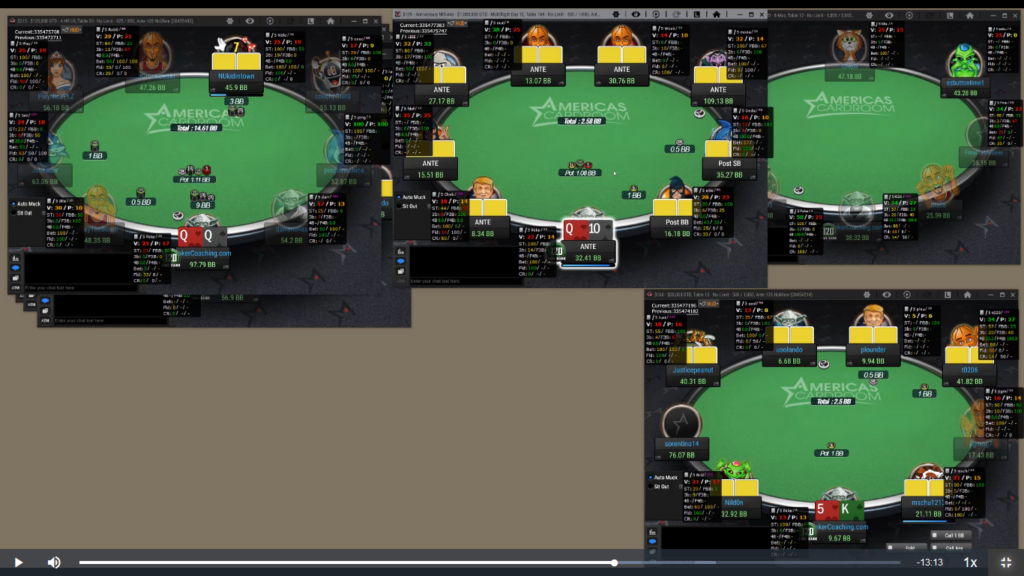
Lower priority tables cascaded top left. Higher priority tables separate.
It really is impressive to watch Little playing 10+ tables and having no issues keeping track and playing as optimally as possible. While he admits that occasionally he does make mistakes, and that will come with mass multi-tabling, his focus and decision making is almost always on point. It was very cool to see him recognize a spot where he needed to fold a flush in one of his smaller buy-in tourneys where a lesser player would have just gone ‘oh, flush, call’, before clicking on to the next decision.
Day 9: Button vs. Big Blind Play
Jonathan Jaffe says he considers button vs. big blind play the most complex area of No Limit Hold ‘em because you’re dealing with such wide ranges in both spots, leading to difficult situations. I’ll happily agree with him. Range analysis in this scenario is very difficult, but Jaffe does a good job as he runs through a simulated session with two of his students using PokerStars play money home game software.
To be honest, this was a bit confusing to follow at times because it was set up visually as a heads up match, with the button player instructed to act as if there was an imaginary small blind between himself and the simulated big blind. There are a bunch of different scenarios presented, but I would recommend primarily listening to Jaffe’s commentary as opposed to watching the action to avoid the visual confusion.
Day 10: Advanced Big Blind Strategies in Tournaments
Day 10 brings another meaty and thorough class with Matt Affleck, which was also one of my favourites in the 30-Day Tournament Preparation Challenge.
Remember the good old days when the big blind would fold too much because they didn’t want to play a junk hand out of position? Remember when it was then determined that it was mathematically correct to defend the BB with a wide range because the pot odds dictated it? Well, now the problem with most players is that they’re defending too wide, and you likely are too, especially multiway!
Affleck discusses how most poker players make a lot of mistakes in the big blind because they assume their pot odds are correct to be seeing a flop in almost any situation that hasn’t been 3-bet. Position of the raise, and the size of the raise are not fully considered, leading to players getting themselves into horrific spots. And just because your pot odds are so fantastic with five players in the pot by no means justifies flicking in a few more chips with a junk hand that can easily be dominated if you hit the board.
The coordination between raw equity, EV, and equity realization % is broken down, with Equilab used to illustrate the key points.
One solution to poor big blind play is to increase your 3-betting. As much as players over defend the big blind by calling, they’re under 3-betting grossly in spots that are very profitable. Most players just default to calling, again ‘since they’re getting such a great price’, but there are plenty of hands that can be 3-bet, and Affleck shows you where and why. Some theories referenced in his short stack videos are applicable here as well, as we’re now 3-betting weak aces to get medium aces to fold. Some marginal suited hands can be 3-bet as well because most people just are not calling enough 3-bets in general, and many hands that would have you dominated are now folding!
Finally, while fewer hands should be defended from the big blind with deeper stacks, the opposite is true with a short stack! It may seem counter-intuitive to defend a higher percentage of your stack when short, but that’s just it. If you’re short, you can happily get your stack in with pairs and good draws, whereas it would be heinous to commit a larger stack with the same hand strength.
Day 11-13: Review of Blaz $10 Online Tournament Win
As mentioned earlier, this 3-part miniseries can be ripped through in a little over an hour, as Little reviews a student’s win in a $10 6-handed tournament. Despite the relatively short runtimes of each of the three videos, there are still many key strategies to take away. None is bigger than the simple reminder that just because a tournament is short-handed, it does not justify opening ranges unnecessarily wide. A 6-handed table is just like a 9-handed table, just that the first 3 players have folded.
Case in point, one of the student’s opponents is playing a ridiculous 79% VPIP with a 13% PFR. Several pots are contested against this player, with maximally exploitative lines discussed in both small and large pots. Plus, not only are they an absolute muffin to play against, a blatant bet-sizing tell is picked up, too!
Once that player is disposed of, other situations are analyzed, including vs. a player the exact opposite of our 79/13 friend. What adjustments need to be made against a far more aggressive player with a high 3-bet percentage?
At the final table, an ICM suicide is narrowly averted thanks to the opponent folding vs. the student’s overplay of third pair with an open-ended straight flush draw on the turn.
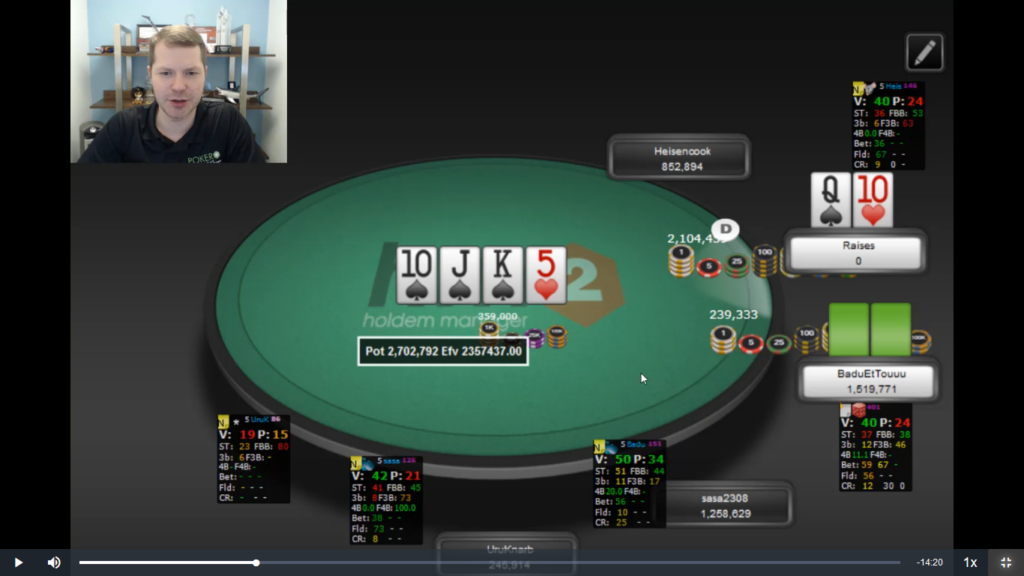
Oh, you got called and the 4 of diamonds rolled off? Cool 3rd pair bro.
Days 14 & 15: How to Complete Poker Coaching Homework & October 2019 Tournament Homework
A staple of any PokerCoaching.com curriculum is the monthly homework assignments, and the 30-Day Tournament Preparation Challenge is no exception.
Using the PokerCoaching.com Range Analyzer, students input their own ranges into a chart based on a hand scenario provided by Little. The student first creates a pre-flop action chart, saves it, then adjusts it street by street, based on the community cards and opponent actions of the hand. Hand combinations are categorized into ranges for premium made hands, marginal made hands, draws, and junk.
The Day 14 video is a tutorial on how to create your charts and save them in the PokerCoaching.com forum for review during the monthly homework webinars hosted by Little. On Day 15 you’ll actually create a series of range charts, and then compare them to the analysis provided in the accompanying video.
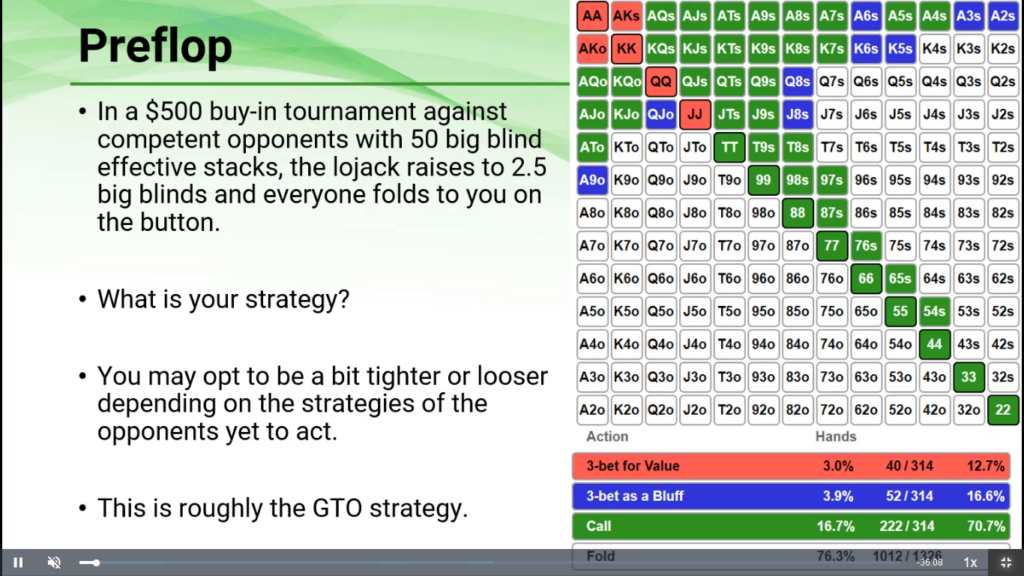
Little will suggest how you should balance your betting and checking ranges, by adding or removing hands from the various categories. I would recommend familiarizing yourself with them though before jumping into these homework assignments. At first, I was a bit overwhelmed by them, but have since learned to love them as a great way to study ranges and work on GTO range balancing.
Days 16 & 17: Reviewing Jonathan’s Deep Run in the Online $1k Freezeout Parts 1 & 2
In this pair of videos, PokerCoaching.com’s GTO wizard Michael Acevedo dissects Little’s play in a deep run against a table full of online killers.
A warning before you dive into these videos. This is VERY high-level GTO hand analysis between Acevedo and Little. Acevedo analyzes mostly to Little’s level of understanding, not necessarily to a student of the site. PioSolver is used frequently, and not explained to the layman poker player at all. You will need to be somewhat familiar with the program.
With that said, indeed, this is some VERY high-level GTO hand analysis!
REVIEW: Michael Acevedo’s Modern Poker Theory Video Packs
It’s fascinating to observe their poker minds at work, breaking down a queen-high river call, discussing the merits of min raising vs. slightly bumping up raise sizes, analyzing when a 15-20 BB shove is recommended (contrary to other short stack lessons), range betting vs. pot control, and tons more.
Remember, this is an elite player analyzing an elite player, playing against other elite players. This is NOT the review of the $10 tourney. There is some discussion of exploitative plays that could be applicable to smaller stakes tournaments, but for the most part we’re flying way above the rim here.
Day 19-23: Mastering the HUD (VPIP & PFR, C-bet, Fold to C-bet, Check-Raise, Test Your Skills)
It’s nearly three weeks into the 30-Day Tournament Preparation Challenge before Alex Fitzgerald makes his first appearance, but the Assassinato’s entire course on Mastering the HUD gets a full five days worth of attention and it’s invaluable.
NOTE: Importantly, if you don’t play in an online poker room that allows HUDs, the 30-day challenge essentially just became a 25-day challenge. You can skip it entirely.
Fitzgerald admits he hated using a HUD at first and actually didn’t for five years. However, if you play on a site allowing HUDs and are not using one, you’re at a tremendous disadvantage against players who are.
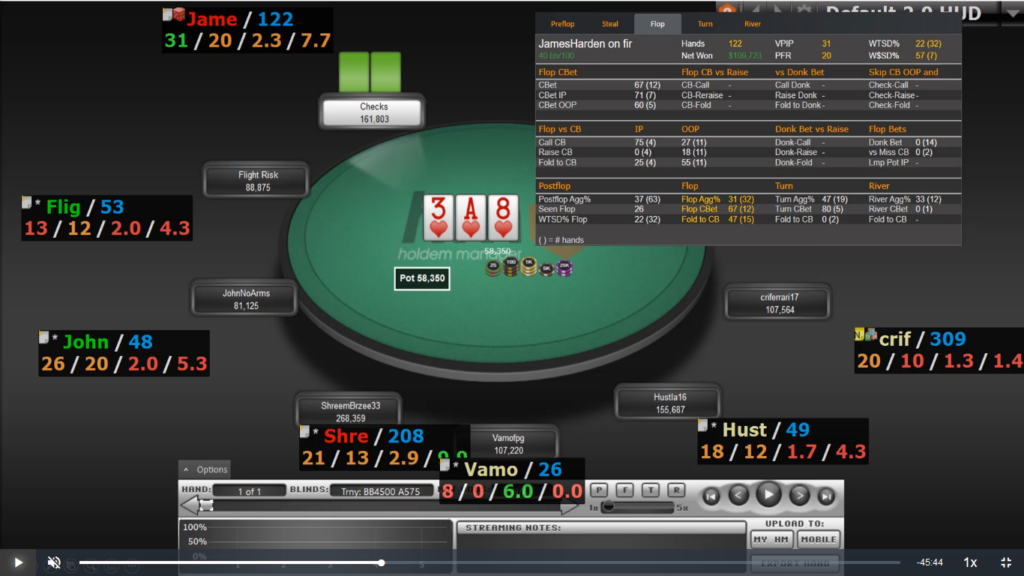
Lots of numbers and colors can be scary, but once you learn them you’ll be the one they fear!
You’ll learn the ins and outs of the key numbers, learning how to play optimally against, and maximally exploit your opponents, based on their statistical tendencies. Fitzgerald acknowledges that unless you’re playing regularly with the same players your sample sizes will be small, but that will still tell you at least as much as in a live tournament setting.
Plenty of hand examples are provided in each section (especially Day 23) for students to consider, not just based on their potential opponent’s stats, but on other players and factors.
After watching this course, I’ve revamped my own HUD and am using it much more effectively. It’s undeniable that the difference in how the game feels based on using or not using a HUD is pretty large. With that said, if you can gain that advantage in decision making based on live analytics, it really is something you should be doing, and this section will prepare you thoroughly.
Day 25: Bubble Thoughts
Little’s 22-minute Bubble Thoughts class is all about pressure, pressure and more pressure; determining if your opponents care about sliding into the money, and if so, making life as uncomfortable for them as possible.
Find out where they don’t want to go, then make them go there!
Jonathan Little
There are obviously specifics to consider, such as stack sizes, position, and player type, and Little will go through what to look for that will give you the green light to attack. Reading weakness is always key to playing aggressive poker, but no time more so than on the bubble.
Several examples are analyzed, including an interesting situation showing how drastically a button shoving range changes on the bubble, depending on the quality of opponents in the blinds. A 64% range dropping down to 8%, sounds extreme, but it is justified against players who will call off too wide.
This section also leads into the next part of the challenge with some ICM discussion, and a reminder to pass on those tiny edges if you have a skill advantage, because ICM doesn’t take skill into consideration.
Day 26: Introduction to ICM
In this section you’ll dive deep into ICM with Matt Affleck. The title may say ‘Introduction’, but this class has heaps of great info throughout the beefy 92-minute runtime.
For those completely unfamiliar, Affleck starts off with a brief discussion on the difference between chip EV and $ EV, with a simple example of a winner-take-all sit n’ go payout vs. a top 3 payout.
The very cool concept of ‘Risk Premiums’ takes up a good chunk of the lesson. Affleck assigns an added percentage to a player’s pot odds when determining whether to make a call (think of it like a calling tax). We know a big stack is risking very little by calling a shove against a short stack, but to see specific formulas incorporated into various all-in situations based on stack sizes is a very cool guide to consider.
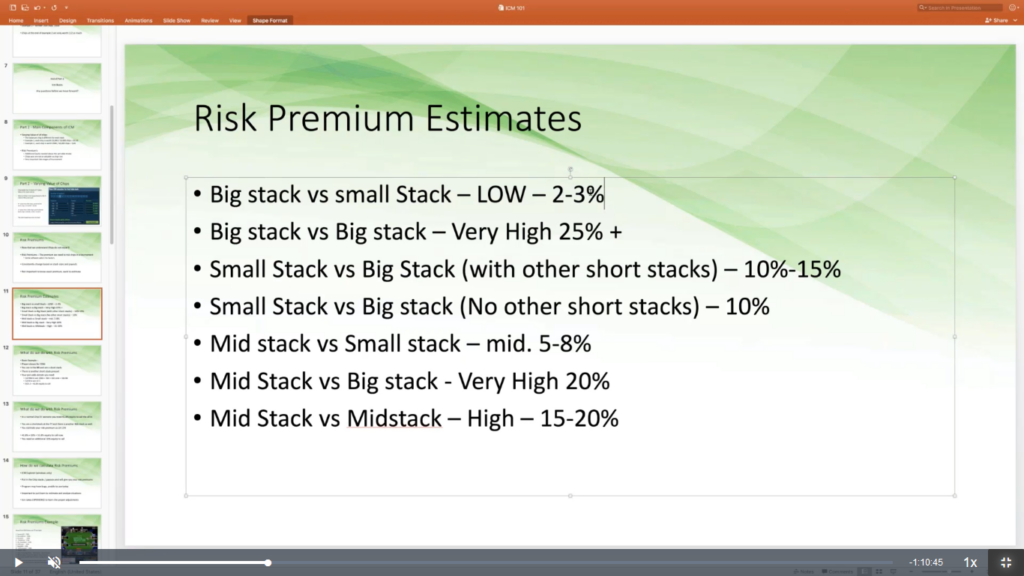
Post-flop ICM consideration with regard to bet sizing is compared to Risk Premiums, as the larger the bet you face, the higher the risk premium. You may seemingly only need 25% pot odds to make a call, but considering ICM and your risk premium, you need as much as 45-50% to justify putting your stack at risk.
Plenty of in-game examples are dissected through ICMizer to determine the profitability of potential all-ins. Consideration of risk premiums are thoroughly incorporated and considered.
Of note, Affleck discusses how risk premiums are even higher in satellite play. In a recent WSOP Online satellite, I was in a lengthy stretch of play with a ton of smallish/medium stacks (myself included) at the table as the bubble approached. Accounting for risk premiums saved my stack in a couple of key spots, whereas had I only considered the pot odds, I would have made an incorrect and tournament-ending decision. Instead, I made tighter folds, where others committed ICM suicide. As a result, I made it to the target tourney while others did not.
Days 27-29: Mastering High Roller Final Tables
We’re into the home stretch as we hit Day 27, and after almost four weeks of hard work this part of the series almost feels like the end of a school year when you’d get treated to watching a movie in class.
Yes, there is obviously a lot of high level poker that can be studied and learned from here, but you can also just kick back and enjoy watching some of the very best in the world play a $2,000 online final table.
Little had not actually watched this final table before doing the commentary on it, so it’s fun to watch him analyze the play in real time.
Since it is an online high roller final table with plenty of wizards, there is a lot to be taken away from it, notably the almost universally EXCELLENT play. Things you’ll see that Little discuses and analyzes include:
- Lots of GTO play
- Additional thoughts on min-raising vs. raising slightly more
- Players knowing when to check their marginal hands
- Tiny C-bets that make it difficult for opponents to defend properly against, instead of ‘betting to make your opponent fold’
- No blind C-betting – lots of consideration of opponents’ ranges
- Proper ICM-related decisions and play
- Minimal over-aggression and unnecessary 3-betting
- Good river decisions; recognizing showdown value and not needing to bluff
- Developing a final table limping range
- High level exploitative plays
- Head- up strategies and ranges
Day 30: Tips to Crush Small Stakes Tournaments and Final Exam
Congratulations! You made it to Day 30!
But before you can say you’ve completed the 30-Day Tournament Preparation Challenge, there’s one more lesson with three tips to crush small stakes tournaments.
Oh… and the final exam! 🙂
You’ll have to check out the video for all the details, but the three tips are:
- Exploit wide ranges! Low-stakes players don’t play well with wide ranges. Little will teach you how to combat these players most effectively, especially in late position.
- Maximally exploit weak players! As you get deeper in tourneys, the stakes get higher and many players will get uncomfortable.
- Play optimally on pay jumps! Your timebank is your friend. No, tanking isn’t sexy, but if it’s the difference in making a pay jump and boosting your ROI, then it’s tank time, baby!
After Little goes through these points, he wraps up with a 40-minute Q & A session with students on a wide variety of topics.
The final exam consists of 30 multiple choice questions, similar to the short quizzes at the end of each day’s lesson. Many of them aren’t too tough, but there are a few that might catch you. But really, if you’ve paid attention and have absorbed the information provided, you should have no problem registering a strong score (ahem…)
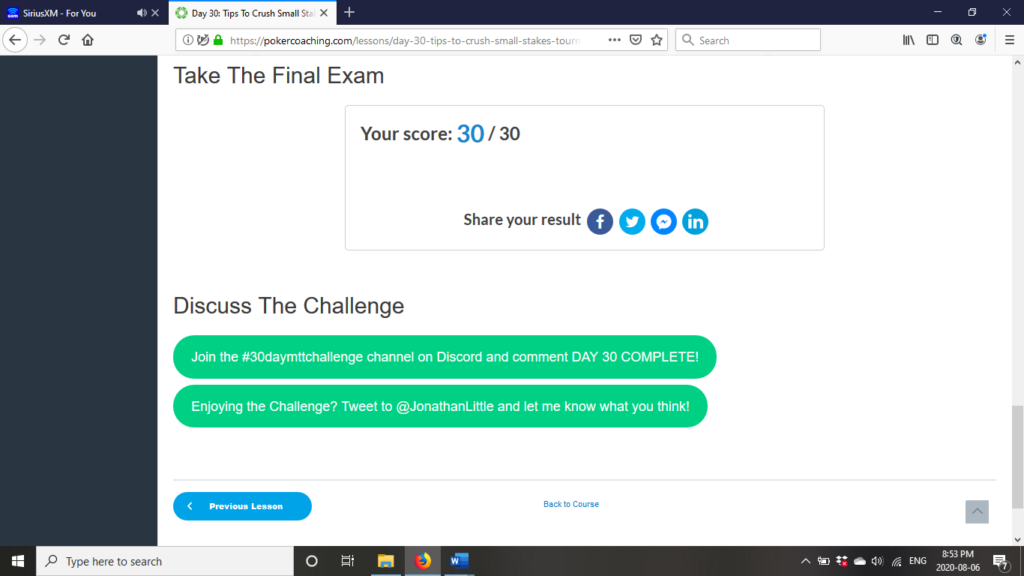
Aced it!
PokerCoaching.com 30-Day Tournament Preparation Challenge: Worth the Price!
As I have mentioned a couple of times in this review, I’ve had immediate success implementing the teachings of the 30-Day Tournament Preparation Challenge, to my own game.
One test of the effectiveness of a training course is how quickly it pays for itself. Well, while working through the challenge for this review, it paid for itself multiple times over! With so many different aspects of tournament play discussed in this series, its an invaluable resource that can be enjoyed by signing up for just 1 month of PokerCoaching.com Premium access.
If you take on the 30-Day Tournament Preparation Challenge and put in the work, improved tournament results are a virtual certainty.
